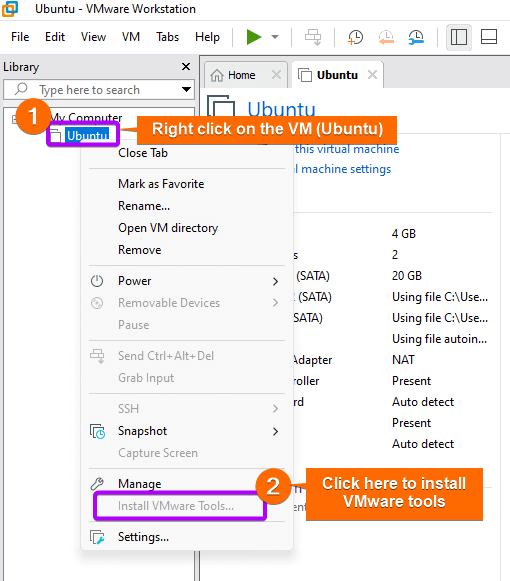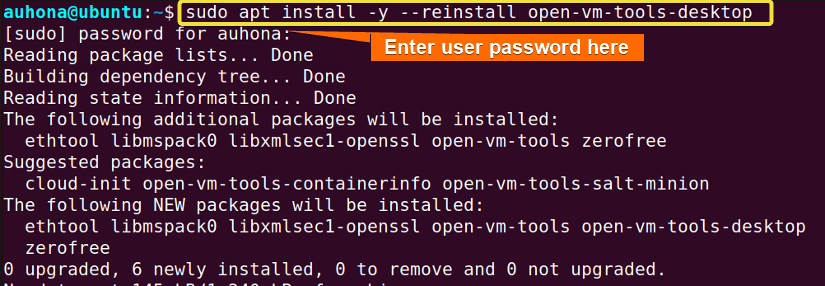FUNDAMENTALS A Complete Guide for Beginners

In virtualized environments, VMware tools serve as a vital component for seamless communication between the host and the guest operating systems including time synchronization, file sharing, and efficient hardware management. There are some instances when VMware tools not running, leading to performance degradation, display problems, and more. A notification becomes visible like VMware tools are not running on a virtual machine [message].
The most common solution for VMware Tools not running is to reboot the guest system or reinstall the VMware tools. To solve the VMware Tools not running issue, check the reinstallation solution:
- First, uninstall VMware tools then reboot the virtual machine.
- Take a backup of the
C:\Program Files\VMware\VMware ToolsandC:\ProgramData\VMware\VMware Toolsfolders by renaming them. Or copy the folders and store them in another separate location. - Reboot and then install VMware tools.
Moreover, this article delves into all the common issues associated with VMware tools not running and provides a comprehensive guide to troubleshooting these issues effectively.
Reasons Why VMware Tools may not be Running
There can be various reasons why VMware Tools might not be running as expected. Those are:
- Compatibility Issues: If you are using an outdated version of VMware Tools that is incompatible with your VMware environment or the guest operating system, it may need to be fixed.
- Installation Problems: If VMware Tools were not installed properly or if there were any errors during the installation process, it may lead to issues with its functionality.
- Service Issues: Sometimes, the VMware Tools service may stop working or fail to start due to various reasons such as conflicts with other services, resource limitations, or software conflicts.
- Configuration Errors: Misconfiguration in the VMware Tools settings or the virtual machine settings can also lead to VMware Tools not functioning correctly.
- Network Connectivity Problems: Issues with network connectivity between the host and the guest operating system can also impact the functionality of VMware Tools, especially if it affects features like time synchronization or file sharing.
- Operating System Issues: Certain operating system updates or changes can sometimes lead to compatibility issues with VMware Tolls. Ensure that the guest operating system is fully supported by the version of VMware Tools you are using.
- Software Conflicts: Other software running on the guest operating system or the host system might conflict with VMware Tools, causing it to malfunction.
7 Solutions to Resolve VMware Tools Not Running Error
To solve the VMware Tools not running error issue, you can try the following 7 troubleshooting methods:
1. Check VMware Tools Installation
Ensure that VMware Tools is installed on the virtual machine. If it’s not installed, you can install it manually.
To install VMware Tools manually, first click on the VM, and run the VM. Then, right-click on the VM and click on the install VMware Tools as below.
2. Check VMware Tools Service:
Ensure that the VMware tools service is running. To check the VMware tools service, run the command in the terminal.
sudo systemctl status open-vm-tools
sudo service vmware-tools-status
sudo apt install --reinstall open-vm-tools-desktop3. Confirm Compatibility
To confirm the compatibility, verify the status of the VMware Tools service within the guest operating system by running:
systemctl status open-vm-tools
4. Verify Network Connectivity
Ensure that the network connectivity between the host and the guest operating system is stable. Troubleshoot any network-related issues that could be impacting the functionality of VMware Tools.
5. Check System Logs
Check system logs for any error messages or warnings related to VMware tools. These logs often provide valuable insights into the root cause of the problem.
To check the Syslog, run tail -f /var/log/syslog in the terminal.
6. Reinstall VMware Tools
To reinstall VMware Tools, you need to uninstall VMware Tools from the virtual machine, and then restart it. Next, make backups of the C:\Program Files\VMware\VMware Tools and C:\ProgramData\VMware\VMware Tools folders by renaming them. After another reboot, proceed to install VMware Tools.
7. Restart Guest OS
If all else fails, try to restart the guest operating system running in the VM. To reboot the guest OS, run sudo reboot in the terminal.
Conclusion
Ensuring the seamless operation of VMware tools is essential for maximizing the benefits of virtualized environments. By understanding the common causes of malfunction and employing a systematic troubleshooting approach, users can effectively resolve issues related to VMware Tools. Regular monitoring and timely updates are key to preventing future disruptions and ensuring the smooth functioning of VMware Tools within the virtualized environment.
People Also Ask
What to do if the VM is not working?
To solve the VM not working issue, ensure there is enough disk capacity to support the virtual machine’s proper functioning. Due to insufficient space on the hard drive, VMware becomes unresponsive. So, check and keep enough space before running or creating any virtual machine.
How do I force restart VMware tools?
To restart VMware Tools, you can follow these steps: Firstly access the virtual machine where the VMware tools are installed. Then open the Task Manager by pressing CTRL+SHIFT+ESC. After that, Locate the VMware Tools service in the list of processes. Then, Right-click on the VMware Tools process and Select ‘End task’ or ‘End Process tree’ to forcefully terminate it. After terminating the process, you can attempt to restart VMware Tools by navigating to the VMware Tools installation directory and running the appropriate command or executable file for restarting the service. Alternatively, you can restart the virtual machine to ensure a complete reset of VMware Tools.
What are the reasons why a virtual machine might fail to power on?
A virtual machine’s inability to power on may be due to any of the following factors:
- Issues with the ESXi operating system.
- File corruption.
- Challenges within the Guest OS.
- File Locking problems.
- License-related complications.
- Network difficulties.
- Problems with Storage array or datastore.
How do I reinstall VMware tools?
To reinstall VMware Tools, follow these general steps: Firstly, access the virtual machine where VMware Tools is to be reinstalled. Then, open the VMware application. After that, select the virtual machine and go to the ‘Guest’ menu. Choose ‘Install/Upgrade VMware Tools’ from the drop-down menu. This action will typically mount the VMware Tools installation disk image within the virtual machine. Then navigate to the mounted image and run the installer appropriate for your guest operating system. Follow the on-screen instructions to complete the installation process. Once the installation is finished, restart the virtual machine to ensure that the changes take effect.
Related Articles
- Installing Ubuntu on VMware Workstation [Easiest Guide]
- A Comprehensive Guide on Installing Kali Linux on VMware
- Installing Arch Linux on VMware [Easiest Guide]
- VMware Shared Clipboard [Enable Copy-Paste & Folder Sharing]
- Installing Ubuntu on VMware Player [Easiest Guide]
- [Fixed] Operating System Not Found on VMware
- VMware Workstation Pro vs VMware Player [Ultimate Comparison]
<< Go Back to Virtual Machine Installation Guide | Linux OS Installation Guide | Learn Linux Basics





